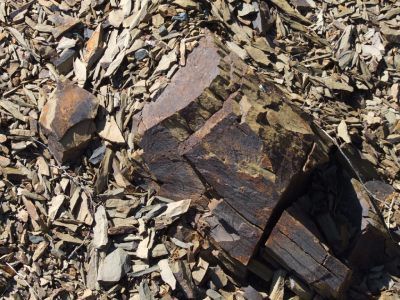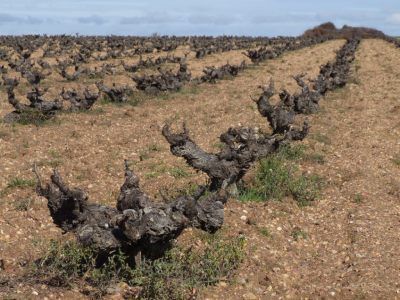What exactly does terroir mean?
The term terroir is the combination of four key factors in the production of quality wines: soil, climate, grape variety and man.

The soil
The composition of the soil, of the land in which the vines take root, is the first defining element of a terroir. We know, for example, that slate wines (El Escocés Volante El Puño) tend to be more intense than those from sandy soils (Las Moradas de San Martín Senda), perfect for showing the aromas of each grape with maximum clarity. Stony soils, on the other hand, give wines of intense colour that transmit warmth (Quinta Quietud), as opposed to clay-limestone soils, which produce wines of greater elegance and rounder fruit (Baigorri B70).
La composición del suelo, de la tierra en la que enraízan las cepas, es el primer elemento definitorio de un terruño. Sabemos, por ejemplo, que los vinos de pizarra (El Escocés Volante El Puño) suelen ser más intensos que los de suelos arenosos (Las Moradas de San Martín Senda), perfectos para mostrar los aromas de cada uva con la máxima nitidez. Los suelos pedregosos, por su parte, dan vinos de color intenso que transmiten calidez (Quinta Quietud), a diferencia de los arcillocalcáreos, de los que se obtienen vinos de mayor elegancia y fruta redonda (Baigorri B70).

The richness of organic matter available in the soil is another determining element that directly influences the concentration of the wine; thus, poor soils tend to produce wines of greater intensity, while those from vineyards with abundant plant food tend to be somewhat more fluid. Yields increase according to the richness of the soil and the more grapes a vine has, the lower its concentration.

The granulometry, that is the size of the soil particles, directly affects its water retention capacity. According to this, soils are usually divided into clay (<0.002 mm), silt (0.002-0.05 mm) and sand (0.05-2 mm), with the clayey soils being the ones that are more compact and retain rainwater better, and the sandy soils the ones that have more difficulties in conserving water reserves.
Other factors, such as the content of active limestone (calcium carbonate), the choice of rootstock (the underground part of the plant) or the depth of the topsoil are directly related to the availability of nutrients and their absorption. In short, we can say that the depth at which the roots must or can work, as well as the support they are provided with, will be responsible for a large part of the wine's character.
The climate
The second determining factor in any vineyard is the climate. How does the climate influence the profile of a wine? What types of climate exist? How do the latitude, altitude or orientation of the vineyard affect the resulting wine? Let's go step by step. Let's start by distinguishing climate from microclimate.

Climate is the sum of all the atmospheric conditions (temperature, rainfall, humidity, winds, sunshine, etc.) typical of a region; a microclimate, on the other hand, is a set of atmospheric particularities that affect a reduced area of territory, giving it characteristics that are different from the generic ones of its area.
In Spain we can distinguish six major climates: Mediterranean, continental, subtropical, arid, oceanic/atlantic and mountain.
Mediterranean climate
The Mediterranean climate is located in the eastern and southern regions closest to the sea and in the Balearic Islands, and is characterised by mild temperatures and moderate rainfall, with dry summers. Mediterranean climate wines are full-bodied and can be reminiscent of liqueur-like fruit. Two examples:
Continental climate
The continental climate is located in the regions furthest from the sea and the ocean, such as Castilla La Mancha, Castilla y León or Aragón. It is defined by an average temperature above 30°C in the hottest month and below 0°C in the coldest month. These same contrasts also occur between daytime and nighttime temperatures in the summer months, allowing the grapes to evolve more slowly, ensuring a good balance between freshness and ripeness in the wine. Two good examples of wines from a continental climate:
Subtropical climate
The subtropical climate is located exclusively in the Canary Islands and is usually described as a warm climate between tropical and temperate, with mild temperatures throughout the year. The humidity-laden trade winds clean and cool the environment and create, depending on the relief, an infinite number of microclimates on the islands. In general, we can consider Canarian wines to be pleasant, aromatic and very balanced. You can taste:
Arid climate
The arid climate is mainly located in the region of Murcia and is characterised by intense sunshine and low rainfall. Arid climate wines are concentrated and juicy with jammy aromas. You only have to drink a glass of Juan Gil Etiqueta Plata to realise this.
Atlantic climate
The Atlantic climate, characterised by the humid influence of the ocean, is located in the northern strip of the Peninsula, from the Basque Country to Galicia. The abundant rainfall that accompanies it for a good part of the year results in aromatic wines of great freshness. They serve as an example:
- A huge Albariño such as Zárate Tras Da Viña
- A refreshing txakoli such as Txomin Etxaniz.
Mountain climate
The mountain climate is found in high altitude areas, such as the Pyrenees, the Cantabrian Mountains or the Central System. In these regions, the sunshine is very high and the temperature contrasts are very pronounced, with really cold nights. This makes it possible to obtain wines with good colour and acidity, with contained alcohol content. Acusp, made in the north of the province of Lleida at an altitude of 1,000 metres, perfectly shows the elegance of mountain climate wines.
Altitude, latitude and orientation of the vineyard
The latitude at which the vineyard is situated, as well as the vertical metres from sea level (altitude) are other key factors, as is the orientation of the vines.
Between latitudes 50º and 30º north and 30º and 40º south, most of the world's vineyards are concentrated; beyond that, vines find it very difficult to thrive. Each latitude brings with it specific temperatures and rainfall, which means that, for example, wines from the north and south of the same country have distinctly different characters. Higher temperatures result in wines with higher alcohol content, while in cooler areas with more pronounced rainfall the grapes tend to be lessconcentrated and, therefore, the wines are more stylized.
Something similar happens with altitude. We know that temperatures drop as the altitude rises, and that the day-night temperature contrast in higher vineyards is crucial for good ripening of the fruit and for its concentration of aromas. At altitude, the skin of the grapes becomes thicker and therefore concentrates more colour and aromas, something that is demonstrated by wines such as Las Hormigas Malbec Gualtallary, an excellent Argentinean Malbec the grapes of which are grown at 1,300 metres above sea level.
The orientation is also of vital importance to find more or less sunshine, a fact that will have a decisive influence on the ripening and the aromatic and taste profile of the wine. In the northern hemisphere, a south-facing vineyard receives the greatest amount of sunlight, while in the southern hemisphere the situation is the opposite, with the south facing vineyard receiving the least amount of sunlight. Thus, in the warmer regions of the northern hemisphere, we plant facing north if we are looking for a coolness that balances our wines (Montebaco Cara Norte) while in the cooler regions it may be advisable to plant facing south to ensure the perfect ripening of the grapes (Leitz Rüdesheimer Riesling Trocken).
The grape variety

The variety is the third factor in the equation. Each grape is unique, some will give us more fruit, others more freshness or body, and they will always do so differently depending on where and how they are grown.
Let's start with the aroma: the most aromatic white varieties are muscatel, gewürztraminer, sauvignon blanc and riesling, among others, while among the white grapes with a more restrained aroma we can find viura; many other white grapes have an aroma that we can consider average, such as chardonnay or garnacha blanca (white grenache).
Among the red varieties, aroma is not so decisive, and more attention is paid to other factors such as colouring capacity, acidity, tannicity or alcohol content. Some grapes such as garnacha tintorera (Alicante Henri Bouschet) have a remarkable colouring capacity, while varieties such as pinot noir colour the wine in a very subtle way. Varieties such as cariñena (carignan) or sumoll give rise to wines with high acidity, very fresh. In our online shop you will find fantastic single varietals of both varieties:
At the other extreme, we can find grapes such as merlot, responsible for pleasant and round wines with a restrained acidity.
If we think of tannicity, that dry sensation that remains in the mouth after taking a sip of some wines, the first varieties that come to mind are tannat (Clos Basté Madiran), cabernet sauvignon (Enate Reserva) and nebbiolo (M. Marengo Nebbiolo d'Alba Valmaggiore).
Finally, with sugar production in mind, the grape varieties capable of producing wines with a higher alcohol content are syrah (Borsao Zarihs) or garnacha (Alto Moncayo Veraton), among others.
Human intervention
Finally, there is man. The quality of any wine depends to a large extent on his skill in interpreting the soil-climate-grape variety triangle. It is man (or a woman) who decides how to prune, when to harvest or at what temperature to ferment the must, all of which are crucial factors in understanding the profile of each wine. We will deal with them in future articles.
If you found this post interesting, follow us on Instagram, Twitter or Facebook so you don't miss any content about wine.